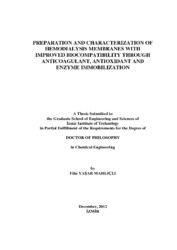Please use this identifier to cite or link to this item:
https://hdl.handle.net/11147/2951Full metadata record
| DC Field | Value | Language |
|---|---|---|
| dc.contributor.advisor | Alsoy Altınkaya, Sacide | - |
| dc.contributor.author | Yaşar Mahlıçlı, Filiz | - |
| dc.date.accessioned | 2014-07-22T13:48:39Z | - |
| dc.date.available | 2014-07-22T13:48:39Z | - |
| dc.date.issued | 2013 | - |
| dc.identifier.uri | http://hdl.handle.net/11147/2951 | - |
| dc.description | Thesis (Doctoral)--Izmir Institute Of Technology, Chemical Engineering, Izmir, 2013 | en_US |
| dc.description | Includes bibliographical references (leaves: 150-159) | en_US |
| dc.description | Text in English; Abstract: Turkish and English | en_US |
| dc.description | xiv, 163 leaves | en_US |
| dc.description | Full text release delayed at author's request until 2016.02.01 | en_US |
| dc.description.abstract | The objective of this thesis is to improve blood compatibility of polysulfone (PSF) based hemodialysis membranes through generating thromboresistant and/or antioxidative surfaces with biomolecule immobilization. To create a nonthrombogenic surface, support membrane was modified with layer by layer (LBL) deposition of polyethyleneimine (PEI) and alginate (ALG) and heparin (HEP) was immobilized on the outermost surface of the assembly by blending with ALG. α-lipoic acid (ALA) and superoxide dismutase (SOD)/catalase (CAT) enzyme couple were choosen to provide antioxidative properties. ALA was immobilized site-specifically to PEI deposited support membrane while SOD/CAT enzyme couple were attached both covalently and ionically on the plasma treated and PEI deposited membranes, respectively. Blending a small amount of HEP with alginate remarkably prolonged the coagulation time (APTT) of HEP free membranes. The stability of ALA under typical hemodialysis conditions was improved by immobilization, and the greatest enhancement was achieved when it was sandwiched between two PEI layers. In vitro studies showed that all ALA or SOD/CAT coated PSF membranes are capable of reducing reactive oxygen species levels in blood, furthermore, they can significantly prolong APTT. The hemocompatibility results also demonstrated that the adsorption of human plasma proteins, platelet and cell activation on all modified membranes decreased significantly compared with the unmodified PSF membranes due to the change in surface properties such as hydrophilicity, surface charge and roughness upon immobilization of the biomolecules. The modification methods proposed in this study did not change high permeability, mechanical strength and nontoxic property of the PSF membranes. | en_US |
| dc.language.iso | en | en_US |
| dc.publisher | Izmir Institute of Technology | en_US |
| dc.rights | info:eu-repo/semantics/openAccess | en_US |
| dc.subject.lcsh | Hemodialysis | en |
| dc.subject.lcsh | Membranes (Biology) | en |
| dc.subject.lcsh | Anticoagulants (Medicine) | en |
| dc.subject.lcsh | Antioxidants | en |
| dc.subject.lcsh | Oxidative stress | en |
| dc.subject.lcsh | Heparin | en |
| dc.subject.lcsh | Lipoic acid | en |
| dc.subject.lcsh | Superoxide dismutase | en |
| dc.subject.lcsh | Catalase | en |
| dc.title | Preparation and Characterization of Hemodialysis Membranes With Improved Biocompatibility Through Anticoagulant, Antioxidant and Enzyme Immobilization | en_US |
| dc.type | Doctoral Thesis | en_US |
| dc.institutionauthor | Yaşar Mahlıçlı, Filiz | - |
| dc.department | Thesis (Doctoral)--İzmir Institute of Technology, Chemical Engineering | en_US |
| dc.relation.publicationcategory | Tez | en_US |
| dc.identifier.wosquality | N/A | - |
| dc.identifier.scopusquality | N/A | - |
| item.languageiso639-1 | en | - |
| item.openairetype | Doctoral Thesis | - |
| item.grantfulltext | open | - |
| item.openairecristype | http://purl.org/coar/resource_type/c_18cf | - |
| item.cerifentitytype | Publications | - |
| item.fulltext | With Fulltext | - |
| Appears in Collections: | Phd Degree / Doktora | |
Files in This Item:
| File | Description | Size | Format | |
|---|---|---|---|---|
| 458865.pdf | DoctoralThesis | 5.9 MB | Adobe PDF |  View/Open |
CORE Recommender
Sorry the service is unavailable at the moment. Please try again later.
Items in GCRIS Repository are protected by copyright, with all rights reserved, unless otherwise indicated.